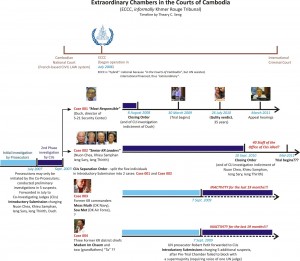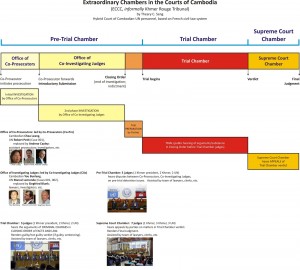May, 2011
now browsing by month
Posted by: | Posted on: May 26, 2011
Closing order of cases 002 (Nuon Chea, Kieu Samphan, Ieng Sary and Ieng Thirith) continue…
CLOSING ORDER
of Co-Investigating Judges You Bunleng and Marcel Lemonde, 15 September 2010
III. ADMINISTRATIVE STRUCTURES (NATIONAL)
- 58. Below the level of the Centre, Democratic Kampuchea was sub-divided into a series of hierarchical administrative entities, all reporting up a vertical chain-of-command, culminating at the Centre. Immediately below the Centre were a number of large “zones”. They were subdivided into “sectors” with each of these containing a number of “districts” within which were a series of “subdistricts” and “cooperatives”.184 At each level, the zone, sector, district and subdistrict tiers of this national structure were each governed by a committee, each of which was headed by a secretary.185
- 59. Immediately after April 1975 there were six zones; North Zone, Northwest Zone, Northeast Zone, Southwest Zone, West Zone and East Zone.186 In 1977, the North Zone was renamed the Central Zone187 and a new North Zone was created.
- 60. In addition to the zones which reported directly to the Centre, the CPK created a number of “autonomous sectors” which bypassed the zone level to report directly to the Centre. These were Autonomous Sector 103 (Preah Vihear), Autonomous Sector 105 (Mondulkiri), Autonomous Sector 106 (Siem Reap), Autonomous Sector 505 (Kratie) and the Kampong Som Autonomous City (Cambodia’s principal Seaport).188 In addition, Phnom Penh itself was categorized as a distinct territory not within the formal national administrative structures, which reported directly to the Centre.189 Autonomous Sector 106 (Siem Reap) was merged with Autonomous Sector 103 (Preah Vihear) to create the New North Zone in 1977.190
Posted in Education, KR Trial, Politics, Researches, Social | Comments Off on Closing order of cases 002 (Nuon Chea, Kieu Samphan, Ieng Sary and Ieng Thirith) continue…
Posted by: | Posted on: May 25, 2011
Khmer Rouge Tribunal: cases 001, 002, 003 and 004
In preparation for the start of trial hearings beginning on 27 June 2011 of Case 002 against the surviving Khmer Rouge senior leaders Nuon Chea, Khieu Samphan, Ieng Sary and Ieng Thirith, KI Media is starting a new series in posting installations of the public document of the Closing Order of Case 002. The Closing Order of the Co-Investigating Judges forms the basic document from which all the parties (Co-Prosecutors, Co-Lead Lawyers for all civil parties, Defense Lawyers) will be making their arguments before the Trial Chamber judges (one Cambodian President, 2 Cambodian Judges, 2 UN judges). Up until now, the hearings involving these four surviving senior Khmer Rouge leaders have been in the Pre-Trial Chamber over issues of pre-trial detention and jurisdictional issues. Beginning in June 2011, the Trial Chamber will hear the substantive arguments over the criminal charges (e.g. genocide, crimes against humanity, penal code of 1956).
. . .
CLOSING ORDER
of Co-Investigating Judges You Bunleng and Marcel Lemonde, 15 September 2010
II. ADMINISTRATIVE STRUCTURES (CENTRE)
A. THE COMMUNIST PARTY OF KAMPUCHEA (CPK)
- 33. As of 17 April 1975, the CPK was governed by a Statute which had been initially adopted at the Party’s first Congress, in September 1960.74 In January 1976, a new Statute75 was adopted at the Party’s Fourth Congress76 that outlined the ideology, membership, structure and organization of the Party. Within the Statute a number of state bodies were particularized: the Revolutionary Army of Kampuchea,77 the national system of Party Committees,78 the Party Central Committee,79 and “various offices and ministries surrounding the Central Committee”.80 The Party itself was governed by a Central Committee and a Standing Committee.81
Posted in Education, KR Trial, Politics, Researches, Social | Comments Off on Khmer Rouge Tribunal: cases 001, 002, 003 and 004













